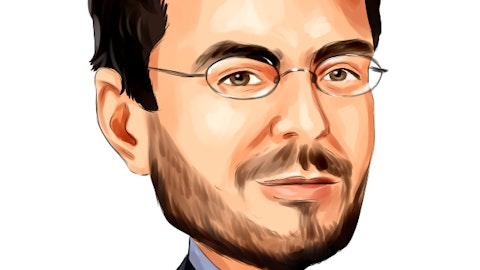Stephen Willey: Okay, that’s helpful. And then with respect to the Phase 3 protocol in chronic neutropenia, I guess, how are you standardizing GCSF reduction withdrawal? Is that just investigator subjectivity? And then is there a way that you’re going to try to statistically quantify that at all?
Christophe Arbet-Engels: Right, so GCSF, as you know, is prescribed individually to patients and there is a lot of variability. So we’re asking our patients in the Phase 3 to remain stable. We want to establish the effectiveness of mavorixafor versus placebo. And we’re going to maintain this. We’re going to allow only modifications of death under a blinded, adjudicated committee for safety reasons. So, for example, if their ANC goes too high or if there is a safety event. But we’re going to be trying to enforce stable treatment of GCSF for the 52-weeks of the trial.
Stephen Willey: Okay. Thanks for taking my questions.
Operator: Thank you. Next question comes from the line of Edward Tenthoff with Piper Sandler. Please go ahead.
Edward Tenthoff: Thank you very much. And good morning, everyone. Two questions, if I may. Firstly, I think I should know this, but is there any open-label extension work being done in WHIMs? In other words, are there currently any patients on mavorixafor? And then the second question, I think you mentioned, if I heard you correctly, that there will be the three patients. More data on those three patients from ASH. Could there be more patients just because of additional time between abstract submission and the actual presentation? Thank you.
Paula Ragan: Sure. So I’ll just do a quick summary. The WHIM OLE is ongoing. We expect to present data on that on the first half of next year. So we’ll look forward to sharing some updates on the patients who are on placebo moving into mavorixafor and those on long term mav [ph]. So stay tuned for that. And then in terms of the three patients in the ASH poster, our intent is to really make sure we have a robust data set around those 15 patients in the first half of next year. I think that’ll tell the fulsome story around how the drug is acting, but we’re really looking forward to presenting the six month data on those three patients on GCSF. There’s a lot of exciting new information amongst those three patients, so stay tuned for that as well, Ed.
Edward Tenthoff: Great. Awesome. I’m looking forward to that. And can you remind me, I know the majority of patients rolled over. How many patients are in the OLE for WHIM? Thanks.
Paula Ragan: So we haven’t given any cuts updates, but I think 90% plus of them rolled over. And I’m actually not sure where the cut is at this point, but we’ll certainly be disclosing that when we get the data updates. Yes.
Edward Tenthoff: Thanks, Paula.
Paula Ragan: Thanks, Ed.
Operator: Thank you. Next question comes from the line of Kalpit Patel with B. Riley Securities. Please go ahead.
Andy Fleszar: Hey, good morning. This is Andy Fleszar on for Kalpit. Thank you for taking the questions. Are you able to give any additional granularity on the timing of the next comprehensive update for the 15 patients? Or if there’s a certain amount of follow up that you’ll be looking for before presenting the results?
Paula Ragan: Sure. Christophe, go ahead. Yep.
Christophe Arbet-Engels: Yes, no, there will be, we will have all of those data in a more comprehensive manner in the first half of next year. The ASH poster will help share some preliminary information and we hope to continue this. I want to remind you that the Phase 2 studies is a six-month study. It’s an open-label, so we could do different analysis. But it is important that we see those six months data and we see this in the largest number of patients to raise the confidence of the preliminary data we are going to be seeing at ASH.
Andy Fleszar: Okay. And then as a follow up to that. Do you anticipate the Phase 2 data to be enriched for cyclic, congenital, or idiopathic CN?



